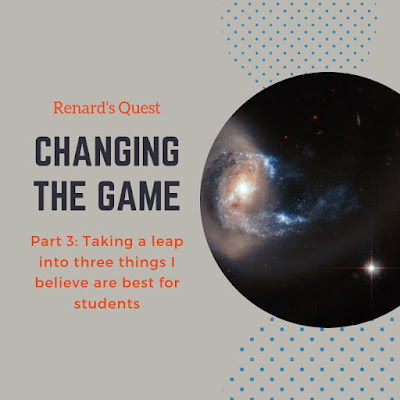In a period of three years, I have become aware of and begun to incorporate three key practices. Obviously, gamification, which adds such a sense of fun to my room that I will likely use elements of it for the rest of my career. The second is mastery learning, in which we work with students, provide feedback and grow toward mastering a concept. This past year, I attempted the use of the Grid Method from the Teach Better Team (@teachbetterteam on Twitter) in math. All students showed good growth and some made gains were mind boggling.
The third is the one that has challenged me the most: personalized learning. As someone who started his career as my students favorite cartoon character, I was the quintessential sage on the stage. We did groups and stations but I was most comfortable with command of the whole class. One, two, three, eyes on me. However, over the last 12 years I have shifted more and more away from that.
So, we now have the Sci-Fighters Academy. Where students enter a science fiction world where they have a tight schedule, but anything can happen.
- Students will engage in Vocabulary Sparing (more here).
- Have short but active mini-lessons that deliver need to know content.
- Then they have time to choose a pathway and complete, what I dubbed, the scientific process.
- We end each lesson with a quick reflection.
Things can of course, shift a bit if we are doing something major. Most days will be very much like this. Through thematic elements like messages for Earth Base 1 and the Danger Deck, students will know that they are training to save the world.
The Scientific Process is the piece that is stretching me, as it is where students have the most control. We have broken up our key information into groups of questions that students must find the answers to. They start by creating a hypothesis about how it relates to our essential question. This serves as a bit of a pre assessment to show what they know.
A big goal of mine this year is to teach students that the internet is more than games, YouTube and Wikipedia. I want to show them how to find answers, learn new information and how to judge what is true and what is made up. So students have a research component where they need to find multiple sources for key information and decide the strength of the different sources.
Then, they will choose one of three pathways to share and apply their learning. This is where I am entering personalized voice and choice. I want students to consider how they want to display what they are learning, so these will be very vague directions that leave a lot of room for interpretation. While I realize I could go further, and I am still limiting them more than full personified learning, this is a big step for me and I need to shift slowly here.
Once their pathway is complete, students need to relate the learning back to the essential question and try to share how what they have learned relates in the big picture. Then, and finally, students will ask what other questions might they have about the topic. The questions are key to this process, as it is completely student paced and for the ones who move quickly they will come back to these questions to go BEYOND!
There is much more to share. How students are sharing their learning, how we intend to grade this, and what is a Danger Deck? I will share more of this soon, but this was a lot for a blog post.
